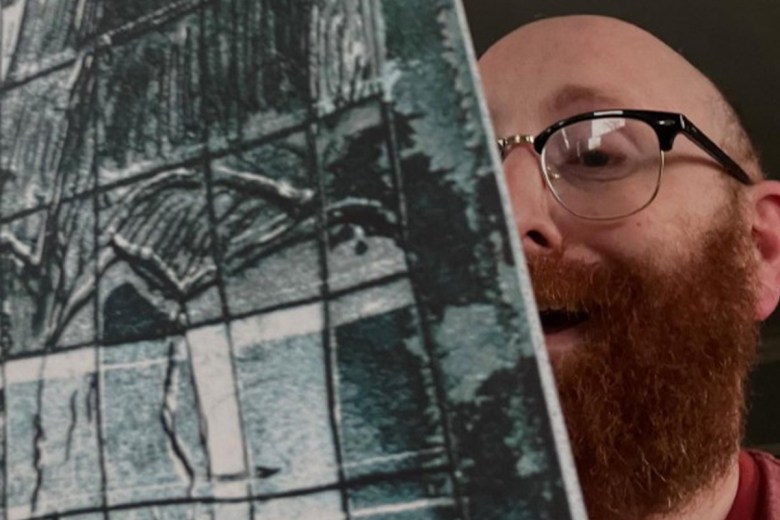 Arist Cooper Whittlesey and his ‘New and Old.’ — Photo courtesy of Cooper Whittlesey
Arist Cooper Whittlesey and his ‘New and Old.’ — Photo courtesy of Cooper Whittlesey
There’s something omnivorously large about Cooper Whittlesey’s aesthetic. He’s obviously spent time studying his craft, even though he might be considered an outsider or underground artist. His work suggests that of Gary Panter, Jean-Michel Basquait and Harmony Korine.
That’s who came to mind when I came across Whittlesey’s book of collected works, New and Old, this spring at the Iowa City zine fair. The collection of drawings, cartoons, abstract works and parodies by the local Iowa City artist are vibrant, witty and dark, and often hilarious. The collection demonstrates many different styles and approaches to the creation of visual art. The sheer variety it contains guarantees that anyone who peruses its pages will be surprised and delighted, perhaps in equal measure.
 Art from Cooper Whittlesey’s ‘New and Old.’ — Photo courtesy of Cooper Whittlesey
Art from Cooper Whittlesey’s ‘New and Old.’ — Photo courtesy of Cooper Whittlesey
In some drawings, I see kinship with the work of Philip Guston. Other influences include underground comics, graffiti, zines, punk rock, industrial design, the tradition of naïve or art brut. All of these have been absorbed and made use of by Whittlesey. As well, certain unusual qualities — jitteriness, scratchiness, glitichness — seem present in Whittlesey’s art, doubtless part of his experience in a world saturated by electronic information and noise.
On one page, eight panels suggest a comic book. The connection between panels is difficult to establish; the effect is like seeing paintings on a gallery wall. The pictures are charming, funny, loopy. Two dogs hug. Three figures are standing. One shovels dirt into another’s face. A woman smokes while holding an umbrella. A photographer uses an antique camera, bending forward, his head covered by cloth, an owl perched on his head. Two people, a man and woman, kiss on a pier-like structure. The man wears a uniform, a sort-of conductor’s hat on his head. Under his arm, he’s holding a child. The child is tipped perilously downward, close to slipping out of the man’s arm. It’s a hilariously off-beat page of portraits and gags, and it exemplifies Whittlesey’s eye and wit.
 Art from Cooper Whittlesey’s ‘New and Old.’ — Photo courtesy of Cooper Whittlesey
Art from Cooper Whittlesey’s ‘New and Old.’ — Photo courtesy of Cooper Whittlesey
Fans of Abstract Expressionism will be amused by certain of Whittlesey’s pages that experiment in full-blown abstraction by means of squiggly lines and related gestures. Often these are wonderfully titled. A dense nest of lines is “The Crowd on New Year’s Eve”. Another that looks like an interstate highway system gone mad is called “Scattered in Practice, In a Fog in Real Life.” A last example has a thick cloud of lines obscuring several cartoon shapes – one looks like Charlie Brown – and is captioned: “What More Brutal Excursions.”
 Work featured on the cover of Cooper Whittlesey’s ‘New and Old’. — Photo courtesy of the author
Work featured on the cover of Cooper Whittlesey’s ‘New and Old’. — Photo courtesy of the author
For those who appreciate their humor off the wall, this collection is perfectly suited. For example, there is the handwritten page that admits, “I wish more people/would start putting mistle/toe over my head so I could learn/& practice & become a better kisser”. This admission is counterbalanced by the observation in larger bolder script: “I Hope Nob-/Ody Shoots/Me in the Face/Or Anywhere.” The tension between these two statements produces a weird and irresistibly funny vibe. The sketch comedy of Tim Robinson comes to mind as a possible correlative. Try and tell me you can’t picture one of Robinson’s manic characters uttering that last line.
Several pages look almost as if seen through 3D glasses, and others look as if 3D glasses are needed for viewing in proper focus. Whittlesey plays with various techniques throughout; while the bulk of his work uses traditional methods, he also creates throwback illustrations via computer. And there are even a few pages of small drawings that would not be out of place as spot art in The New Yorker.
If you take the time to study Whittlesey’s New & Old Art, really look at its sly provocations and insults, its gentle teases and self-deprecations, its outrageous tweaks and burlesques, its brilliant critiques of nostalgia and angst and cliché and the purpose-filled life, and seemingly any other subject to which you might care to allude, you will be richly rewarded with something close to an antidote, something that seems both psychologically revealing and deeply purifying.
Whittlesey offers an experience like that encountered at the finest punk rock show: at the end you might not know what it was you’ve witnessed but you sure as hell know it was good for you.

